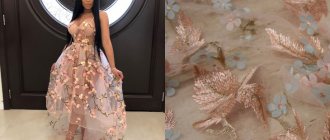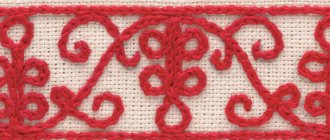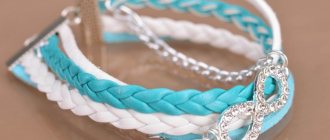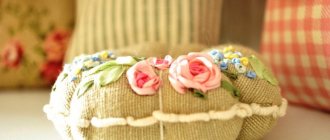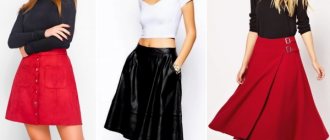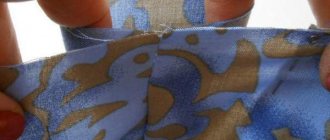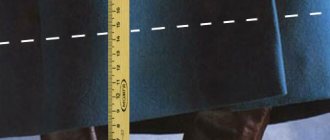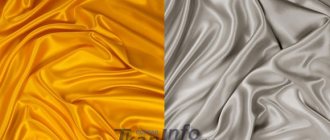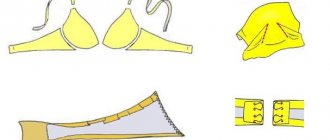Weaving of fabrics: the type and pattern of the front surface of the fabric depends on the type of weaving of the warp and weft threads.
Types of weaving.
Depending on the complexity, weaving weaves are divided:
1. Simple (smooth) 2. Finely patterned 3. Complex 4. Large patterned
Simple (smooth) weaving:
— plain — twill — satin-satin
Plain weave:
The warp and weft threads alternate through one thread.
Plain weave pattern.
Plain weave fabrics have the same surface. Rapport is equal to two threads. Plain weave is used to produce: Cotton fabrics: chintz, calico, voile, cambric. Linen fabrics: edging, canvas. Silk fabrics: crepe de Chine, crepe georgette. Woolen fabrics: cloth and suiting fabrics.
Twill weave
has a distinctive feature - a “hem”.
Twill weave pattern.
On the front surface, the scar goes from bottom to top from left to right. Characteristic features: the smallest number of threads in a repeat is 3. When laying a weft thread, the weaving pattern shifts by one thread. Twill weave is indicated by the fraction: number of main overlaps / number of weft overlaps. Twill: 1/2, 1/3, 1/4 - weft Twill: 2/1, 3/1, 4/1 - warp. Twill weave has greater elasticity and softness, but less density than plain weave, because the floors are more elongated.
Satin weave
The fabrics have elongated overlaps on the front surface - therefore the front surface is smooth and shiny.
There are weft threads on the surface of the satin. Satin weave pattern.
On the surface of the satin are the main threads. Satin weave pattern.
Rapport of at least 5. Satin weave is used to produce cotton fabric - sateen. Satin has a high weft density. The following fabrics are produced using satin weave: Cotton-paper: sateen-double, eraser Silk: crepe-satin, corset fabrics, lining. Satin-satin fabrics have increased abrasion resistance, but these fabrics are very free-flowing and slip when cutting.
Derivative weaves are obtained by complicating or changing a simple weave.
Derivatives of plain weave: rep weave and “matting”.
Rep weave
is formed by lengthening the warp or weft threads, i.e. The main thread can go through 2-3 or more weft threads (or the opposite weft thread can go through 2-3 or more warp threads). Reps can be longitudinal or transverse.
Longitudinal rep weave pattern.
Cross weave pattern.
"Rozhka"
- double or triple plain weave.
Weaving pattern "matting".
Derivatives of twill weave: reinforced twill, compound twill, broken twill.
Reinforced twill
differs from plain twill in that there are no single overlaps in its weave. Dress fabrics: plaid, cashmere (2/2) Suit fabrics: Boston, Cheviot (3/3)
Complex twill
- alternating diagonal scars.
Broken twill
(“Herringbone”)
Satin weave derivatives: reinforced satin.
Combined weaves
:: - crepe - ornamental - relief - openwork
Ornamental weaves
create patterns on the surface of the fabric in the form of stripes, cells and contours.
Crepe weaves
. Elongated overlaps are scattered across the front surface, giving the fabric a fine-grained appearance.
Relief weaves
- form a pattern on the fabric with protruding threads: waffle fabrics.
Translucent weaves
give the fabric an openwork look. The warp or weft thread moves to form a gap.
Complex weaves
are formed from three or more thread systems. Complex weaves include: - two-face - two-layer - pique - pile - loop - leno
Satin_weaving_from_paper_pattern
Weaving of fabrics: the type and pattern of the front surface of the fabric depends on the type of weaving of the warp and weft threads.
Types of weaving.
Depending on the complexity, weaving weaves are divided:
Simple (smooth) weaving:
Plain weave:
The warp and weft threads alternate through one thread.
Plain weave pattern.
Twill weave
has a distinctive feature - a “hem”.
Twill weave pattern.
Satin weave
The fabrics have elongated overlaps on the front surface - therefore the front surface is smooth and shiny.
There are weft threads on the surface of the satin. Satin weave pattern.
- Satin weave fabric - main characteristics and range overview
On the surface of the satin are the main threads. Satin weave pattern.
Derivative weaves are obtained by complicating or changing a simple weave.
Distinctive features
Twill weaving is a type of weaving in which parallel diagonal ridges appear on the fabric. The intersection of the lobe and weft threads is formed with a shift of one, two or three. Thus, each thread overlaps not one opposite one, but several.
Distinctive features of twill are:
Diagonal scars on the surface of the tissue. The line runs diagonally along either one axis or the other;
Fewer points of weaving than in plain, but more threads in a particular area;
- Smoother fabric surface, resistant to abrasion and creasing.
Properties of fabrics with satin weave
Whatever threads the fabric is woven from, satin weave gives it certain properties:
- smoothness,
- density,
- softness,
- shine,
- wear resistance,
- maintaining color saturation after dyeing.
This type of textile has a drawback: when cutting fabric with an extended overlap, the sections can crumble significantly. Working with satin requires skill. Shedding does not in any way affect the wear resistance of the finished product. Another property that can be regarded as a minus is sliding. It is recommended to sleep on satin bed linen in cotton pajamas. When sewing clothes, a lining is required.
Weave Specifications
The linear and surface densities determine how high quality the fabric is in terms of strength and resistance to environmental factors. Linear density is determined by the number of threads in a section of fabric and depends on the raw materials used in weaving.
Surface density is the mass per unit area. It depends on the type of twill weaving and the number of weaves in the repeat.
The required values of linear and surface density are regulated by quality standards, namely GOST 9599-61 and GOST 4403-91. Recently, a new GOST R 58828-2020 has been introduced with references to other quality standards.
Types of materials and their applications
Fabrics with a satin weave are called satin. Initially, the material was made from silk. Today, the raw materials can be both natural and artificial and synthetic fibers.
Several examples of satin fabrics, their properties and applications:
- Fabrics such as crepe satin are made from silk yarn. The textile is based on raw silk threads, and the weft is made from crepe silk (with a very strong twist). These are expensive materials. On the front side, crepe satin is shiny and grainy, on the back side it is matte and smooth. The fabric is pleasant to the body. It is used for sewing delicate items: evening dresses, blouses, suits for celebrations. An interesting property of crepe satin is that both sides of the fabric can be used for clothing.
- Based on cotton fibers, fabrics are made that are close to silk in smoothness, but at the same time are much cheaper. Cotton sateen is light and soft, it is often used for sewing bedding sets. Fabrics can be plain-dyed or printed. Properties of cotton sateen: strength, resistance to frequent washing, hygroscopicity, pleasant cooling effect.
- Wool is used to produce expensive thin and dense fabric - drape-satin. It is very warm, does not wrinkle, protects from the wind, and fits the figure beautifully. Used for sewing outerwear.
- Satin-woven polyester has a silk-like appearance. It is just as smooth and shiny, but the properties of synthetic material are not as good. It becomes electrified, slips a lot, and wrinkles. The skin in such fabric practically does not breathe. The advantage of polyester fabrics is their low cost.
- Blended fabrics are made from polyester and cotton fibers, for example, polysatin. Curtains, tablecloths, bedspreads, bathrobes and other home textiles are made from canvas. Polysatin with a predominance of synthetic threads can cause irritation and roll up.
The best of natural
Chintz reminds me of my childhood. Pleasant to the touch, soft, delicate chintz is ideal for children's and home clothes, but will be a poor choice for office or holiday wear. The chintz is equally smooth on both sides. The quality of the thread determines the fabric:
- cotton - chintz, calico, voile, cambric.
- linen - trim, canvas;
- silk - crepe de Chine, crepe georgette;
- woolen – cloth and costume fabrics.
Satin is denser and stronger than chintz, it is silky to the touch on the front side, durable, holds its shape quite well, like all cotton fabrics, and allows air to pass through well. Suitable for sewing men's and women's clothing - dresses, blouses, shirts. Ideal for making bed linen.
Twill stands apart among inexpensive fabrics, as it is considered technical, although it is used in tailoring. To improve its quality and use in various fields of production and aviation, synthetic fibers are added to natural raw materials, sometimes in significant quantities. Only the diagonal twill weave remains unchanged. a fabric that is perfectly suitable for tailoring ; trousers of modern models fit especially well. The fabric is comfortable to wear, holds its shape well, wears out little, and is also inexpensive.
What is satin weaving
The fabric consists of two lines of yarn: warp and weft. The appearance and properties of the fabric depend on their weave. The overlap is the place where the weft and warp threads intertwine. The satin weave of the fabric uses an elongated overlap. This makes the fabric look smooth. If twisted yarn is used, the finished material acquires relief and shine.
Satin weave pattern: The weft thread covers four or more warp threads. Satin weave is similar to satin. In the latter case, the warp threads are predominant; they overlap four weft threads.
It is this weave that makes the material soft and smooth: the threads with this arrangement are less likely to break.
Subtypes of weave
According to the ratio of weaves between the lobar and transverse threads, twill is divided into two subspecies:
- equilateral
- the sides of the fabric are identical, the weaves of the lobe and weft threads are equal to each other;
- versatile
- the main or weft predominance is expressed, the threads form longitudinal overlaps on different sides, that is, on the front side the lobes will clearly predominate, and on the back - the weft, or vice versa.
There is another classification of twill weaving, which relates to subtypes of complex weaving:
- complex
- has diagonals of warp or weft threads of different widths on the fabric relief; - broken line
- described by a change in the direction of diagonal scars at an angle, resulting in a kind of “herringbone”;
- the reverse
is almost the same as the broken line, but in addition to changing the direction of the scars, the scar itself also shifts.
Colored paper rug: woven
This activity on weaving strips of paper teaches a child to work with scissors, helps develop creative imagination, eye, attention, aesthetic taste, and independence. And also in the process, fine motor skills of the hands develop and responsibility for one’s work is developed.
A paper mat can be offered to children 6-7 years old.
Before starting classes, adults should prepare and make a model on which the child will rely.
For the rug you will need:
How is twill weave created?
The technological process of creating a twill weave consists of interlacing warp and cross threads at a predetermined interval.
The warp (share) thread is directed along the fabric, the weft thread is directed across. Along the edges of the fabric, an edge is created that protects the fabric from unraveling - this is achieved by tighter weaving along the edges of the fabric. The process of creating twill fabric on a machine is as follows:
The warp threads are wound on a beam, then advanced through movable healds and reed.
The healds go down and up one by one, leaving a shed into which the weft thread will pass.
Depending on the type of twill, the shuttle moves along the shed between three, four or more warp threads, pushing the transverse thread.
The weft thread overlaps two or more warp threads, leaving a visible strip that makes up the diagonal.
The resulting fabric is compacted using a reed, and then the finished fabric is wound onto a roller.
How to care for satin
Care is selected according to the composition of the fabric. In most cases, satin fabrics are resistant to frequent washing, do not fade, and do not wrinkle. Both machine and hand washing and the use of bleaches are allowed. Fabrics also need to be ironed using special modes. With proper care according to the recommendations on the label, an item with a satin weave will last a very long time.
Satin weaving is included in the group of basic types along with satin, twill and plain. Excellent wear resistance, beautiful appearance and pleasant texture make satin fabrics popular in various areas from bed linen to fashionable wardrobe items.
A repeating weave pattern in fabric is called rapbrt. Rapport is determined by the number of threads included in it. A distinction is made between warp rapport R0 and weft rapport Ry. The weave is also characterized by a shift - a number showing how many threads are removed from the overlap of the next thread from the previous one. A distinction is made between vertical shift - between adjacent warp threads and horizontal shift - between adjacent weft threads.
Simple weaves include: plain, twill, satin and satin.
Signs of formation of weaving twill weave
- The minimum number of threads in a repeat is three.
- The weaving pattern shifts by one thread with each subsequent insertion of the weft thread.
Twill weave fabrics (Fig. 5) are distinguished by characteristic narrow oblique stripes (lining twill, tartan, etc.). On the front side of the fabric, the oblique stripes are more convex. If you look at the fabric in the direction of the warp threads, they run from bottom to top and from left to right.
Rice. 5. Twill weave
Such fabrics are characterized by high slip. Therefore, when cutting, it is necessary to ensure that there is no distortion of the fabric during laying.
Signs of the formation of weaving satin and satin weaves
- The minimum number of threads in a repeat is five.
- The weaving pattern is shifted in each horizontal row by two threads.
For fabrics made with satin and satin weaves, the front side is smooth and shiny due to the rare interweaving of the warp and weft threads and is sharply different from the back side.
If the front side of the fabric is made from weft threads, the fabric is called satin, and the weave is called satin (Fig. 6).
Rice. b. Satin weave
If the right side of the fabric is formed from warp threads, the fabric is called satin, and the weave is called satin (Fig. 7). Some cotton, linen and silk fabrics are produced using satin weave.


